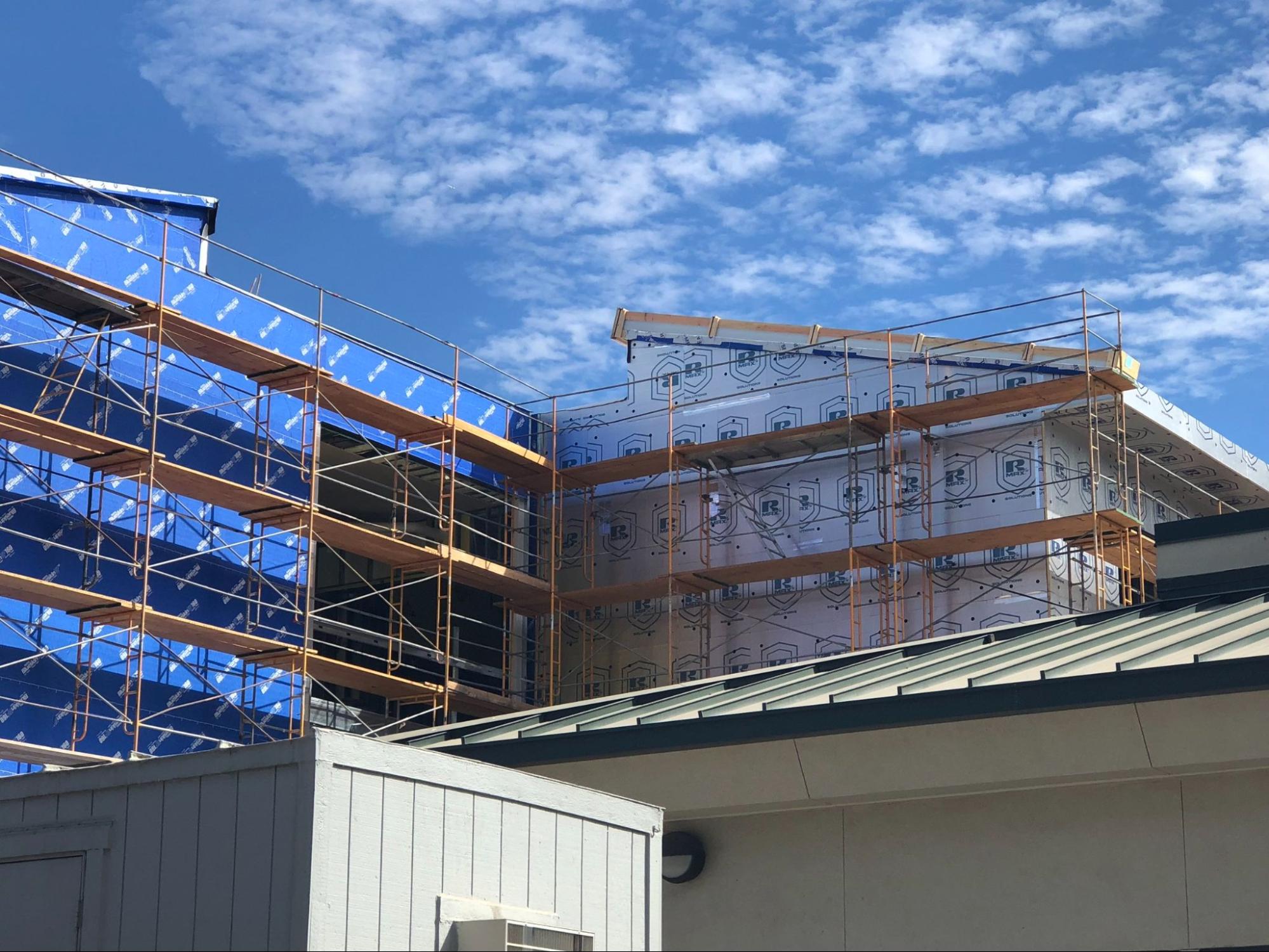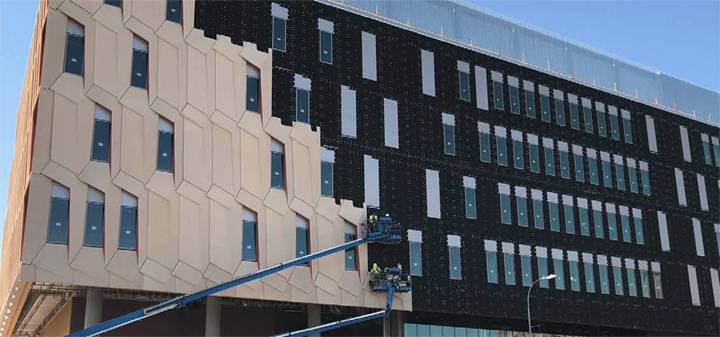Building insulation is a vital element within the building envelope, particularly in commercial settings. Properly specified insulation materials play a crucial role in enhancing energy efficiency, thermal performance, sound transmission, and compliance with commercial building code insulation requirements and standards. The requirements and standards help to ensure that the building envelope functions effectively in regulating temperature, comfort, and overall sustainability.
Why Building Insulation Matters
Building insulation enhances energy efficiency, and reduces heating and cooling costs while also minimizing environmental impact. It maintains consistent indoor temperatures, to help ensure occupant comfort and well-being by preventing drafts and temperature extremes.
Insulation also contributes to sound attenuation to create quieter, more peaceful indoor environments. Ultimately, insulation aligns with sustainable practices by conserving energy resources and reducing greenhouse gas emissions for a greener and more efficient built environment.
Energy Efficiency
The primary role of insulation is to enhance energy efficiency. Properly installed insulation creates effective thermal barriers, and reduces heat transfer through walls, ceilings and floors. This minimizes the need to access heating and cooling resources, which results in lower energy consumption, cost savings, and a reduced carbon footprint.
Reflective insulation can also deflect radiant heat, particularly in attics, to further reduce cooling demands in warm climates.
Comfort and Indoor Air Quality
Insulation acts as part of a barrier system against outdoor pollutants, allergens, and moisture, to minimize the entry of contaminants and improve indoor air quality. Maintaining consistent indoor air temperatures can also help to regulate humidity levels in order to reduce the risk of mold growth. Insulation's combined effects on temperature control and air quality ensure that building occupants enjoy a comfortable and healthier indoor space, to enhance overall well-being and productivity.
Regulatory Compliance and Safety
The specification of building insulation is subject to various regulatory compliance and safety standards, including the International Building Code (IBC) and energy codes such as ASHRAE 90.1. These codes set minimum requirements for insulation R-values, fire safety, and moisture control.
Safety standards such as the ASTM E84 assess the surface burning characteristics of insulation materials. For environmental safety, insulation products may need to comply with regulations such as the Toxic Substances Control Act (TSCA) in the U.S.
Building Insulation Types
There is a wide variety of building insulation products available, including fiberglass, foam board, spray foam, cellulose, and mineral wool. They vary in forms and R-values for different insulation needs and applications.
Fiberglass Insulation
Fiberglass insulation is made of fine glass fibers. It's available in batts, rolls, or loose-fill forms. It's widely used for its cost-effectiveness, fire resistance, and ease of installation. It provides good thermal insulation due to its low thermal conductivity. Typical R-values range from R-11 to R-38, depending on thickness and density.
Cellulose Insulation
Cellulose insulation is made from recycled paper that has been treated with fire retardants. It has good thermal insulation properties, and insulating an value that typically ranges between R-3.2 to R-3.8 per inch, which makes it an effective choice for energy efficiency, when installed properly.
Foam Board or Rigid Foam Insulation
Rigid foam insulation is a dense, solid material that offers high thermal resistance due to its low thermal conductivity. Insulating values vary by type (e.g., XPS, EPS, or polyiso) but typically range from R-4 to R-8 per inch. It's known for its effectiveness in controlling heat transfer.
Extruded Polystyrene (XPS)
Extruded polystyrene (XPS) insulation is a type of rigid foam board insulation. It offers excellent thermal performance with R-values typically ranging from R-5 to R-5.5 per inch. XPS is moisture-resistant and durable, which makes it suitable for various building applications, especially in areas where moisture control is critical.
Expanded Polystyrene (EPS)
Expanded polystyrene (EPS) insulation is a lightweight, foam board cellular plastic material. It's installed in walls, roofs, and floors as rigid boards or beads. EPS has a good insulating value, typically ranging from R-3.6 to R-4.2 per inch. It's easy to work with, offers moisture resistance, and is cost-effective in various construction applications.
Polyisocyanurate (Polyiso)

Polyisocyanurate insulation, often referred to as polyiso, is a rigid foam board. It's used in various applications, including roofs and walls. It has a high insulating value, typically ranging from R-6 to R-7 per inch, which makes it effective in reducing heat transfer and improving energy efficiency, when properly installed.
Spray Foam Insulation
Spray foam insulation is a liquid material that converts to a foam when applied. It's sprayed onto surfaces, where it expands to fill gaps and create an airtight seal. Its insulating value is excellent, typically ranging from R-6 to R-7 per inch. It provides superior air and thermal barrier properties.
Mineral Wool Insulation
Made from mineral fibers, mineral wool insulation comes in batts or loose-fill forms. It's installed in walls, attics, and between floors. Its insulating value is good, typically ranging from R-3 to R-4.3 per inch. Mineral wool offers fire resistance and sound absorption, in addition to thermal insulation.
Radiant Barrier Insulation
Radiant barrier insulation reflects heat rather than absorbing it. It's installed in attics, under roofs, or in walls. Its primary function is to reduce radiant heat transfer. While it doesn't have a traditional R-value, it enhances energy efficiency by reflecting heat radiation, particularly in hot climates, to help maintain cooler indoor temperatures.
Understanding Building Insulation Requirements
Properly specified and installed insulation reduces heat transfer and controls temperature fluctuations within structures. It is a fundamental component of construction, and is essential to meeting building code requirements that ensure energy efficiency, occupant comfort, and safety.
National and Local Building Codes
In North America, the building codes governing insulation include the International Energy Conservation Code (IECC) and ASHRAE 90.1 for energy efficiency standards. The International Residential Code (IRC) and International Building Code (IBC) also set insulation requirements for residential and commercial structures. Local codes and standards may further apply, with requirements specific to addressing local climate characteristics. Compliance with these codes ensures that insulation materials and practices meet energy efficiency, fire safety, and structural standards, to contribute to the overall performance and safety of buildings.
Climate-specific Requirements
Meeting local codes ensures that buildings are properly insulated to withstand regional weather conditions, for improved energy efficiency and occupant comfort. Climate-specific insulation recommendations may include using higher R-values in colder regions and proper vapor barriers in humid climates.
R-value and U-value
R-value and U-value are metrics used to assess the thermal performance of insulation materials. R-value measures the resistance to heat flow, and indicates how effective an insulation material is at preventing heat transfer. Higher R-values signify better insulation.
The U-value measures the overall heat transfer through a building component, including insulation, windows, and structural elements. Lower U-values indicate better thermal performance. R-value is typically used for insulation materials, while U-value assesses the thermal conductivity of entire building assemblies. Both values are essential for determining a building's energy efficiency and for selecting the appropriate insulation materials and construction methods.
Thermal Bridging
Thermal bridging occurs when heat easily flows through areas with poor insulation or conductive materials, which leads to energy waste and potential condensation. Insulation acts as a vital barrier against thermal bridging, by reducing heat transfer and maintaining consistent indoor temperatures.
Fire Safety Standards
Many insulation types are designed with fire retardants to resist ignition and limit flame spread. Fire-rated insulation is specifically engineered to withstand high temperatures and prevent rapid fire propagation.
Common standards include ASTM E84 (measuring flame spread and smoke development), ASTM E119 (evaluating fire resistance of structural elements), UL 723 (assessing surface burning characteristics) and NFPA 285 (crucial for exterior wall assemblies' fire performance). Compliance varies by insulation type, location, and building codes, to ensure that insulation materials meet the required fire safety standards for their intended applications, and to safeguard occupants and property from potential fire hazards.
Sound Insulation Requirements
Insulation reduces sound transmission by absorbing and dampening sound waves, improving acoustic comfort, and meeting sound insulation requirements. It helps prevent noise from outside or adjacent rooms from penetrating interior spaces, to create quieter environments. An entire wall assembly must be considered to achieve a specific Sound Transmission Class (STC), which may be a requirement for multi-family construction, schools, public facilities and other commercial or industrial buildings.
Insulation with properties conducive to meeting specific STC requirements possesses high density and sound-absorbing qualities. Dense materials, like mineral wool and fiberglass can effectively block sound transmission, while softer, porous insulation can absorb sound waves.
Building Insulation for Different Areas
Insulation needs vary for different building areas, such as walls, roofs, floors, and windows. Materials should be selected based on properties that are best-suited to specific installation areas. Product selection must also be made to ensure compliance with relevant building codes and climate requirements.
Walls
For wall applications, insulation materials like fiberglass batts, mineral wool, and spray foam are commonly used. They provide effective thermal and sound insulation, are easy to install, and can be configured to meet various building code insulation requirements, which makes them a versatile choice.
Roofs and Attics
Typical insulation materials for roof and attic applications include spray foam, fiberglass batts, blown-in insulation, and rigid foam boards. These materials offer effective thermal resistance, easy installation, and compatibility with various roof and attic designs.
Floors and Foundations
Various types of insulation are installed for floors and foundations to create a thermal barrier to reduce heat transfer between interior and exterior, as well as between floors in a building. For floor and foundation applications, insulation options include rigid foam boards, spray foam, and mineral wool. Fiberglass batts are also commonly used for floor insulation by placing them between floor joists or under subflooring.
Windows and Doors
Insulation prevents air infiltration, which is a significant source of heat loss or gain. By sealing gaps around windows and doors, the need for energy expenditures for heating or cooling is reduced. When installing windows and doors, several insulation types are effective. Expanding foam insulation, particularly low-expansion varieties, can fill gaps and voids to create an airtight seal. Fiberglass or mineral wool insulation can be used around the window or door frame to enhance thermal resistance.
Case Studies

Arizona State University's Interdisciplinary Science and Technology Building 7 is a cutting-edge research facility that has been designed to promote sustainability and innovation. The goal was to achieve LEED Gold or Platinum certification, emphasizing both function and construction. Cavityrock Black rigid insulation was chosen for the building envelope due to its ability to withstand exposure and provide consistent R-value, thermal performance, fire resistance, and sound insulation.
The insulation product's bonded black mat fleece facing maintained a clean aesthetic while enduring exposure to the elements. Cavityrock Black met the unique challenges of the open-joint facade, for superior thermal performance with an R-value of 4.3 per inch. Its low flame spread and smoke development indices outperformed other black scrim materials, which made it an excellent choice for this sustainable research hub.

The construction objective for theOLIVE, a 120-unit luxury apartment building, was to combat noise and the effects of harsh climate, in order to provide a comfortable and energy-efficient home for future renters.
At the time of its build, theOLIVE was the first multi-family building of its kind in the heart of Salt Lake City. The primary challenge was sound control from neighboring bars, restaurants, and the Utah Jazz Vivint Arena, as well as air traffic from a nearby airport.
Knauf EcoBatt® Insulation was selected for the job. As a fiberglass insulation, EcoBatt® offers proven performance for superior thermal and sound control. The ability to meet the architect’s strict sound control requirements was a critical factor in the selection of insulation. It expands and recovers very quickly, which makes it easy to fit the cavity. It was used in the ceilings, corridors, and shared walls. For added comfort and energy efficiency, EcoBatt® was installed above building code insulation requirements.
Find the Best Insulation Solutions with Acelab
Acelab is a cloud-based collaboration platform that offers a range of tools and resources to help architecture professionals research, compare and select building products for their projects.
With Acelab, users can access product data, technical specifications, and CAD details from leading manufacturers, as well as tools to create and manage project libraries, product lists, and specification documents. Acelab is designed to help architecture professionals save time and streamline their workflows by providing a centralized source of information and tools for building product research and specification tasks.

